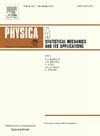Vibration-resonance chimeras in coupled excitable systems with heterogeneous aperiodic excitations
IF 2.8
3区 物理与天体物理
Q2 PHYSICS, MULTIDISCIPLINARY
Physica A: Statistical Mechanics and its Applications
Pub Date : 2024-10-09
DOI:10.1016/j.physa.2024.130156
引用次数: 0
Abstract
In this work, we present a novel chimera-like state known as the vibration-resonance chimera (VRC) state, which is induced by heterogeneous aperiodic (HA) excitations and emerges within the optimal range of amplitude for the HA excitations. We investigate the dynamic behaviors of the FitzHugh-Nagumo model in relation to HA excitations and coupling strength in parameter spaces, identifying specific regions where VRC states exist and analyzing the transition mechanisms between different dynamic behaviors. Using basin stability measures, we find that the mean period of HA excitations affects the multi-stable states of neural systems. Specifically, the model excited by HA excitations with a larger mean period is more likely to exhibit multi-stable states. Additionally, we explore the effects of two levels of heterogeneity in HA excitations, namely amplitude heterogeneity and period heterogeneity, on VRC states. Amplitude heterogeneity can suppress the occurrence of VRC states, whereas period heterogeneity can promote their generation. This work provides valuable insights into complex system dynamics, enhancing our understanding of chimera states in neuronal models and their potential applications in neural networks.
具有异质非周期性激励的耦合可激系统中的振动-共振嵌合体
在这项工作中,我们提出了一种被称为振动-共振嵌合(VRC)态的新型嵌合态,它由异质非周期性(HA)激发诱导,并在 HA 激发的最佳振幅范围内出现。我们研究了 FitzHugh-Nagumo 模型在参数空间中与 HA 激发和耦合强度相关的动态行为,确定了 VRC 状态存在的特定区域,并分析了不同动态行为之间的过渡机制。通过盆地稳定性测量,我们发现 HA 激发的平均周期会影响神经系统的多稳态。具体来说,平均周期越大的 HA 激发模型越有可能表现出多稳定状态。此外,我们还探讨了 HA 激发的两个层次的异质性(即振幅异质性和周期异质性)对 VRC 状态的影响。振幅异质性可以抑制 VRC 状态的出现,而周期异质性则可以促进 VRC 状态的产生。这项研究为复杂系统动力学提供了宝贵的见解,加深了我们对神经元模型中嵌合态及其在神经网络中潜在应用的理解。
本文章由计算机程序翻译,如有差异,请以英文原文为准。
求助全文
约1分钟内获得全文
求助全文
来源期刊
CiteScore
7.20
自引率
9.10%
发文量
852
审稿时长
6.6 months
期刊介绍:
Physica A: Statistical Mechanics and its Applications
Recognized by the European Physical Society
Physica A publishes research in the field of statistical mechanics and its applications.
Statistical mechanics sets out to explain the behaviour of macroscopic systems by studying the statistical properties of their microscopic constituents.
Applications of the techniques of statistical mechanics are widespread, and include: applications to physical systems such as solids, liquids and gases; applications to chemical and biological systems (colloids, interfaces, complex fluids, polymers and biopolymers, cell physics); and other interdisciplinary applications to for instance biological, economical and sociological systems.

 求助内容:
求助内容: 应助结果提醒方式:
应助结果提醒方式:


